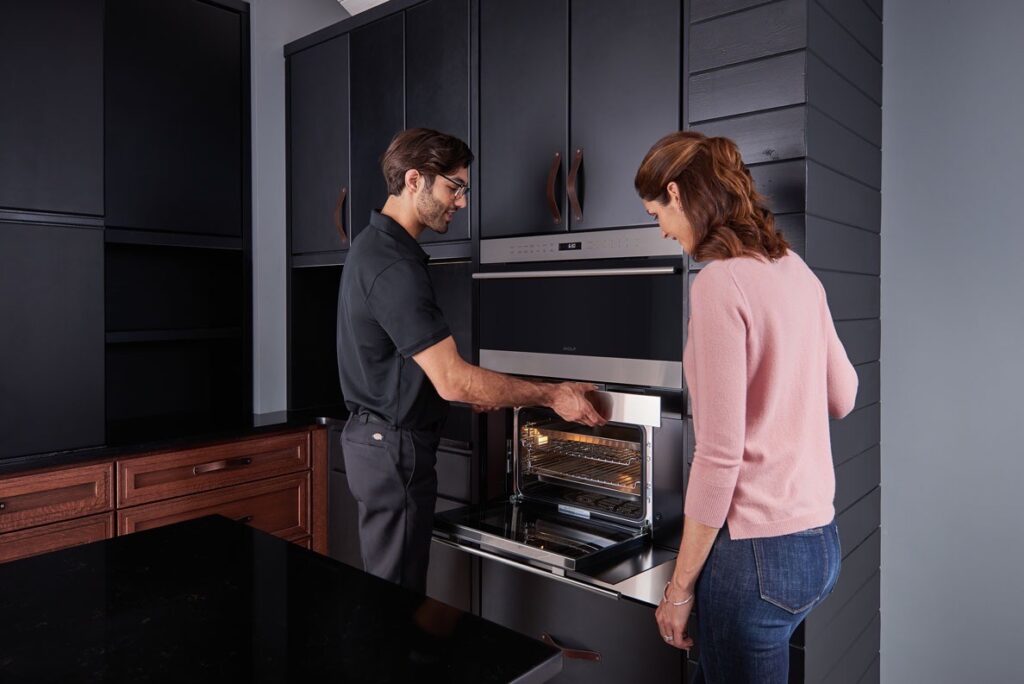The Ultimate Guide to Do It Yourself Home Appliance Repair Work Strategies
From fridges to dishwashing machines, comprehending just how to repair and fix these devices can save you time and money. Are you prepared to uncover necessary strategies that will encourage you to take care of fixings with confidence?
Understanding Typical Home Appliance Troubles
When you count on your home devices, it can be annoying when they all of a sudden stop functioning or act up. Recognizing typical appliance troubles can assist you fix issues properly.
If your oven isn't heating, damaged aspects or thermostat issues can be to criticize,. Dishwashers frequently experience problems with water drainage, so see to it the filter is tidy and the drain tube isn't kinked.
Likewise, pay attention for uncommon audios; they commonly suggest mechanical problems. By identifying these indicators, you can save time and possibly avoid pricey repair services. A little understanding goes a lengthy method in keeping your appliances, so remain informed to keep everything running efficiently.
Important Devices for DIY Repairs
Before diving right into DIY home appliance fixings, it is essential to collect the right devices to guarantee the process goes efficiently. Beginning with a good set of screwdrivers, consisting of both flathead and Phillips, as they're essential for opening up most appliances. You'll additionally desire a pair of pliers for grasping and turning cords or small parts.
Don't fail to remember a multimeter; it aids you examination electrical elements and detect concerns successfully. An outlet collection comes in handy for loosening or tightening bolts, while an utility knife can be valuable for reducing cords or opening up packaging.
Lastly, take into consideration having a flashlight on hand to illuminate dark spaces inside your appliances. With these vital tools, you'll be fully equipped to deal with numerous fixings, conserving both time and cash. So, collect your gear and prepare yourself to roll up your sleeves!
Security First: Precautions to Take
Prior to you begin any type of home appliance fixing, it's vital to prioritize safety and security. Make certain you wear personal safety tools, detach the power resource, and keep your workplace arranged. These simple precautions can help protect against accidents and guarantee a smoother repair procedure.

Personal Protective Tools
Safety and security equipment is a crucial component of any type of DIY home appliance repair work task. Steel-toed boots are additionally a wise choice, specifically when raising hefty home appliances. Remember, being prepared with the ideal gear keeps you secure and concentrated on completing your repair efficiently.
Power Source Disconnection
To ensure a safe do it yourself home appliance repair work, separating the power source is necessary. Prior to you begin any job, you ought to turn or disconnect the device off the circuit breaker. This straightforward step protects against electric shocks and warranties that you can concentrate on the fixing without fretting concerning unexpected activation. Always double-check that the home appliance is off by testing it with a voltage tester. If you're managing larger devices, like a washer or dryer, ensure to secure the power cable and stay clear of any type of call with water. Remember, safety and security first! As soon as you're confident that the power is detached, you can with confidence proceed with your repair services, knowing you've taken the needed precautions to secure on your own.
Workspace Organization
A well-organized workspace can make all the distinction in your do it yourself device repair work job. Begin by clearing your office of clutter to avoid accidents and diversions. Set out all your tools and products, organizing comparable things with each other for very easy accessibility. Utilize a toolbox or organizer to maintain tiny components like washers and screws contained and classified. See to it you've got adequate lights; it'll assist you see details plainly and lower the danger of blunders. Do not fail to remember to keep safety and security equipment like gloves and goggles available. Have a trash bag handy to dispose of waste without delay. A neat space not only enhances effectiveness but additionally keeps you safe while you deal with your appliance repair.
Step-by-Step Guide for Fridge Repair Works
When your fridge begins acting up, it can be aggravating, however dealing with the issue on your own can conserve you time and cash. Inspect for typical problems like temperature level variations or unusual noises. For a noisy fridge, check the fan and verify it's not obstructed.
If there's water pooling inside, evaluate the door seals for damages or dust, and tidy them if essential. For ice build-up, clear the defrost drainpipe. Once you've resolved the concern, connect the refrigerator back in and check it for a few hours. If the issue lingers, you may require to replace a defective component, like the compressor or follower motor. Remember, don't hesitate to consult the manual or seek specialist help if required.
Taking Care Of Cleaning Maker Issues
Just like refrigerators, cleaning machines can present their own set of challenges, but numerous issues can be fixed with a bit of troubleshooting. If your maker won't start, inspect the power cord and verify it's plugged in.
If your clothes aren't getting tidy, consider the water level and detergent type; using excessive detergent can produce excess suds, impacting efficiency. For leaks, check out the hose pipes for splits or loosened links. Tightening up these can commonly address the issue. Routine maintenance, like cleaning the filter, can prevent several concerns from occurring. Keep in mind, a little troubleshooting goes a long way in maintaining your cleaning device running smoothly.
Troubleshooting Ovens and ovens
Just how can you fix common concerns with your oven or range? Start by examining the power supply. Ensure it's connected in and the circuit breaker is not stumbled. If it's a gas oven, verify the gas shutoff is open. Next off, test the heaters: if they don't spark, cleanse her explanation the igniter and check this content for clogs in the burner ports.
If your stove isn't home heating, inspect the temperature level setups and confirm the door seals tightly. A damaged burner could likewise be the offender; you may need to replace it if it's harmed.
For uneven cooking, revolve your pans and think about using an oven thermostat to verify precise temperature levels. Finally, if you listen to uncommon noises or odor gas, shut off the home appliance right away and get in touch with a professional. By complying with these actions, you can recognize and settle numerous typical oven and oven concerns successfully.
Fixing Dishwashers Made Easy
When your dishwasher starts breaking down, it can be discouraging, yet resolving usual concerns isn't as tough as it appears. You'll learn step-by-step troubleshooting methods that will help you pinpoint the problem, together with the vital tools you'll need to tackle repair work yourself. Let's make fixing your dishwasher a breeze!
Common Dishwasher Problems
While dishwashers are developed to make your life simpler, they can sometimes encounter usual concerns that leave you really feeling annoyed. One regular issue is bad cleaning performance; this usually takes place as a result of blocked spray arms or dirty filters. You could likewise discover water pooling near the bottom, which can suggest a malfunctioning drain or a kinked hose. If your dishwasher's door will not latch, maybe a straightforward problem with the latch device or door seal. Additionally, weird noises can signal loosened parts or damaged elements. Ultimately, if you smell something weird, it could be time to check for food particles or a malfunctioning motor. Addressing these problems early can save you time and problem in the future (Subzero Repair Service Dependable Refrigeration & Appliance Repair Service).

Detailed Troubleshooting
Before diving right into repair work, index it's vital to recognize the particular concern your dishwasher is dealing with. Beginning by inspecting if it's unclean properly. Examine the spray arms for obstructions and warranty they spin easily. If it's dripping, analyze door seals and tubes for any damages. For strange noises, pay attention very closely during cycles; foreign things may be stuck in the filter or impeller. If your dishwashing machine will not begin, examine the power supply and door latch. Do not forget to consult your customer guidebook for repairing suggestions certain to your version. By systematically resolving each potential issue, you can pinpoint the problem and take the required actions to fix it, making your dishwasher function like new again.
Vital Repair Tools
When fixing your dish washer,Having the right tools at your disposal can make all the distinction. Begin with a screwdriver set, as you'll typically need both Phillips and flathead options. A multimeter's essential for detecting electric problems, while pliers can aid you grip and adjust numerous components. Do not fail to remember a bucket or towels for any water splashes during repairs.
You might likewise desire a degree to guarantee your dish washer's properly lined up. With these essential tools, you'll be fully equipped to take on any dishwashing machine fixing difficulty that comes your means.
Frequently Asked Questions
Just how Do I Determine if an Appliance Deserves Fixing?
To establish if an appliance's worth repairing, consider its age, repair work expenses, and present worth. If repairs exceed half the replacement expense, you may intend to buy a brand-new version instead.
Can I Find Replacement Components Locally for My Home Appliance?
Yes, you can typically find replacement components locally for your appliance. Check equipment shops, device service center, or local classifieds. Don't neglect to bring the design number to guarantee you obtain the right component!
What Typical Mistakes Should I Avoid When Fixing Home Appliances?
When fixing home appliances, avoid rushing through diagnostics, ignoring safety and security preventative measures, or utilizing wrong tools. Do not avoid reading handbooks or watching tutorials; they give crucial support. Be individual and thorough to assure effective fixings and avoid more damage.
For how long Does a Normal DIY Device Fixing Take?
A typical DIY appliance fixing normally takes one to three hours, depending upon the intricacy. You'll want to collect your products and tools initially, and follow directions carefully to prevent unneeded hold-ups.
Exist Any Kind Of Guarantees for Do It Yourself Home Appliance Repairs?
When you tackle DIY home appliance repair services, service warranties normally don't cover your work. Nevertheless, some suppliers might honor guarantees for components you change. Always inspect your device's service warranty terms prior to beginning any repair work to prevent problems.
Prior to diving right into Do it yourself device fixings, it's vital to collect the right tools to guarantee the procedure goes efficiently.Prior to you begin any kind of home appliance repair service, it's essential to prioritize safety and security.To ensure a safe Do it yourself device fixing, separating the power resource is essential.An efficient job location can make all the distinction in your DIY appliance repair task. Constantly inspect your home appliance's guarantee terms before beginning any kind of repair work to avoid issues.